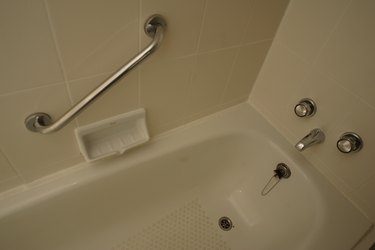
As soon as you suspect your bathtub is leaking water into the wall or floor, stop using the bathtub until you find and repair the leak as well as any damage produced by the leak. Finding the origin of a bathtub leak can require thought, patience and time, but you must stop the leak before your house suffers major damage.
Pinpointing the Leak
Video of the Day
You must first pinpoint the exact location of the leak at the side of your bathtub before you can repair it. If you find water damage on the ceiling directly below a certain point on the bathtub's side, you cannot assume the water fell straight down. Instead, look into the subfloor between the ceiling and the bathtub, if possible, to watch the leak's pathway. From inside the bathtub you may look for anything that would allow water to leak out, such as missing or cracked caulking or grout between the tiles on the wall at the edge of the tub. Spraying water in different areas of the tub can help eliminate possible sources, since the site of the leak will allow water to leak onto the ceiling below when you spray that area.
Video of the Day
Damage
Before repairing the leak, assess the damage the leak has caused. Just because you cannot see damage does not mean the leaking water has not caused any. Water may have saturated the drywall that sits behind the tub's surround, damaged the subfloor or even helped start mold growth in the wall or subfloor. If the floor or wall seems spongy or weaker than what surrounds it, this is a sign of potential water damage. Cut into the floor or wall to investigate further.
Safety Risks
If you do not do anything about the leak, you may be putting your health and safety on the line. Even small water leaks that go undetected and unrepaired over long periods can lead to major water damage in your house, rotting structural wood such as the floor joists or wall studs. The water may also promote mold growth, which can ruin drywall, wood or other materials.
Preventing Mold Growth
Mold growth should always be a concern whenever you find water damage in your house. Even though no mold may be visible at the time, if you do not take action after finding a leak, mold may grow in an area you cannot see, spreading unnoticed until you have a major problem. If drywall or other porous materials are soaked with water, you should replace them, since mold may grow inside them. With harder materials you can clean sith a bleach and water mixture to kill mold spores or growth.